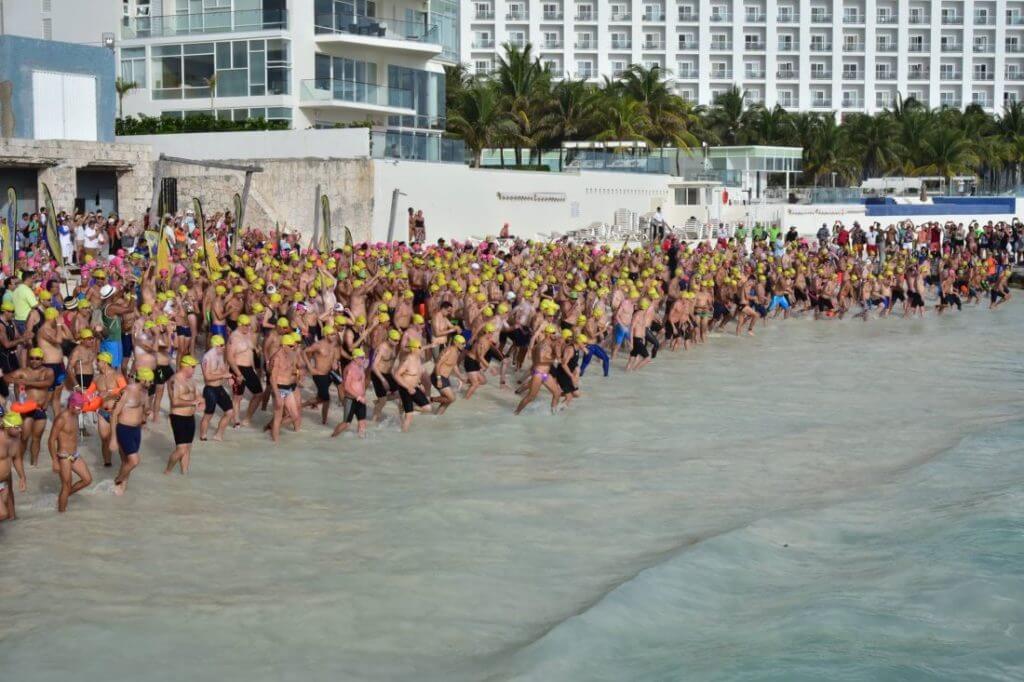The Wild Nature Of Open Water Starts and Finishes

The Wild Nature Of Open Water Starts and Finishes
The sport of open water swimming takes several forms. We’ll divide this discussion into three categories: FINA Circuit; Amateur races; and solo swims. Each have their own required starts and finishes.
The FINA Circuit for Elite Racers
What: Olympics; World Championships; Regionals such as European, Pan-American, Pan-Pacific; Marathon Swim World Series Cup; UltraMarathon Swim Series.
Swimmers: From 20 to 100
Starts: Behind a rope/imaginary line
The Women’s 10k Marathon – Rio 2016
Swimmers start at the water’s edge, behind a boat or diving/jumping off a floating start pontoon. The marathons of 10k and above take about two to eight hours and the shorter 5k takes just under one hour. There is some contact at the start, but referees are in place to keep this under control.
Finishes: Swimmers generally swim under and reach up to touch (wrist timer) an overhead pad. These races generally involve swimming in packs (like cycling) and end in a finish sprint involving up to 10 swimmers who are separated by a few seconds or less.
Men’s Elite 10k Marathon – Doha
Amateur Races

Photo Courtesy: Ned Denison
These races can range from swims of less than 2k (Alcatraz; Midmar Mile in South Africa; Great North Swim – England; and Liffey Swim – Dublin) to 2k to 9k (Waikiki Roughwater – Hawaii; Cadeques – Spain) or to 10k to 20k (Rottnest – Australia). Some are more than 20k (Lake Zurich – Switzerland; River Ganges – India).
Swimmers: From 10 to 20,000-plus (that’s correct!)
Starts: Starts are the same as the FINA Circuit, beginning behind a rope or at the water’s edge. They may begin behind a boat or by diving/jumping off a floating start pontoon/large boat or fixed dock/pier. Other options include from a beach (with an ankle timer) and running over timing pad, or starting knee deep along a beach and behind a physical or imaginary line in deep water. Swimmers are not allowed on Alcatraz, so a water start is required for the Escape!
What it’s like to swim the Alcatraz Sharkfest Race
Finishes: The finishes are the same as the FINA Circuit, with competitors swimming under and reaching up to touch (wrist timer) an overhead pad. Other options include a low touch pad (with a wrist timer), running up the beach and running over a timing pad or across an imaginary line in the water (example: under a bridge). For swims without electronic timing, athletes touch and yell their number or touch and collect a numbered place card or stick.
Safety: It is now rare to have a start/finish where the swimmers are not “checked in” and “check out” to ensure all are accounted for during the event.
Swim Waves: When there are more than 100 swimmers, there are often waves determined by age, sex, wetsuit/not, with disabilities or based on speed from an entry form. Placements are determined in various categories, such as five-year age groups, sex, wetsuit/not, with disabilities and overall. There are still some mass starts (500+) without waves, with the the smaller and slower swimmers generally smart enough to start a bit behind or to a far side to avoid major contact in the first few hundred meters.
There are at least three types of wave starts:
Some events start the fastest first so they don’t “swim over” the slower swimmers. Occasionally, a few swimmers from the FINA Circuit will join one of these swims and are generally placed in the front start line, or set off in a special first wave. In handicapped starts, the slowest are let out first and the fastest last, with the winner determined by “first in.” This continues to be the practice in epic races such as the Liffey Swim in Dublin and can result in the most exciting finishes. In theory, every swimmer’s “handicap” is set by an independent official who knows their pedigree to theoretically result in all finishing together. Meanwhile, in a half-stagger start, the slowest go first and the fastest last, with the winner determined by quickestswim times.
Solo Swims
These are the classics like the English Channel and Catalina Channels and around the Island of Jersey (just off the coast of Northern France), where each swimmer is focused on their individual challenge.
Starts: There may or may not be a set starting location or the starting location is decided by the pilot, depending on the current and expected conditions. The traditional start is from a beach with the “water in front” as the swimmer walks in. The swimmer may reach the start by car/foot, or swim in from the escort boat. Other starting locations include touching the high harbour wall in Jersey or a cliff on one of the Santa Barbara Islands (California) or behind an imaginary line in the water (like under a bridge). Generally, the start is not off a man-made pier.
Finish: There may be a set location or it might be the nearest land across a channel. The traditional finish is to walk up a beach with the “water behind.” A set finish location (for Catalina, the beach at Palos Verde) can sometimes introduce an “extra degree of difficulty.” The ocean current may sweep a swimmer away from the landing and result in a Did Not Finish (DNF) after 10+ hours.
In the history of the 33k English Channel, swimmers have landed on a 40k spread of French coastilne. Some swimming associations allow wall finishes (touch a cliff face for example) or allow for the swimmer to get within 50 meters of a surf crashing beach/wall.



